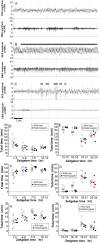A new mouse model of GLUT1 deficiency syndrome exhibits abnormal sleep-wake patterns and alterations of glucose kinetics in the brain
- PMID: 31399478
- PMCID: PMC6765196
- DOI: 10.1242/dmm.038828
A new mouse model of GLUT1 deficiency syndrome exhibits abnormal sleep-wake patterns and alterations of glucose kinetics in the brain
Abstract
Dysfunction of glucose transporter 1 (GLUT1) proteins causes infantile epilepsy, which is designated as a GLUT1 deficiency syndrome (GLUT1DS; OMIM #606777). Patients with GLUT1DS display varied clinical phenotypes, such as infantile seizures, ataxia, severe mental retardation with learning disabilities, delayed development, hypoglycorrhachia, and other varied symptoms. Glut1Rgsc200 mutant mice mutagenized with N-ethyl-N-nitrosourea (ENU) carry a missense mutation in the Glut1 gene that results in amino acid substitution at the 324th residue of the GLUT1 protein. In this study, these mutants exhibited various phenotypes, including embryonic lethality of homozygotes, a decreased cerebrospinal-fluid glucose value, deficits in contextual learning, a reduction in body size, seizure-like behavior and abnormal electroencephalogram (EEG) patterns. During EEG recording, the abnormality occurred spontaneously, whereas the seizure-like phenotypes were not observed at the same time. In sleep-wake analysis using EEG recording, heterozygotes exhibited a longer duration of wake times and shorter duration of non-rapid eye movement (NREM) sleep time. The shortened period of NREM sleep and prolonged duration of the wake period may resemble the sleep disturbances commonly observed in patients with GLUT1DS and other epilepsy disorders. Interestingly, an in vivo kinetic analysis of glucose utilization by positron emission tomography with 2-deoxy-2-[fluorine-18]fluoro-D-glucose imaging revealed that glucose transportation was reduced, whereas hexokinase activity and glucose metabolism were enhanced. These results indicate that a Glut1Rgsc200 mutant is a useful tool for elucidating the molecular mechanisms of GLUT1DS.This article has an associated First Person interview with the joint first authors of the paper.
Keywords: ENU mutagenesis; Epilepsy; GLUT1DS; Glucose transporter 1.
© 2019. Published by The Company of Biologists Ltd.
Conflict of interest statement
Competing interestsThe authors declare no competing or financial interests.
Figures





Similar articles
-
Transgenic expression of the human Glucose Transporter1 (GLUT1) gene locus reduces disease burden in Glut1 deficiency syndrome model mice.Neurobiol Dis. 2025 Oct 1;214:107047. doi: 10.1016/j.nbd.2025.107047. Epub 2025 Aug 5. Neurobiol Dis. 2025. PMID: 40754252
-
From splitting GLUT1 deficiency syndromes to overlapping phenotypes.Eur J Med Genet. 2015 Sep;58(9):443-54. doi: 10.1016/j.ejmg.2015.06.007. Epub 2015 Jul 17. Eur J Med Genet. 2015. PMID: 26193382
-
Glucose Transporter 1 Deficiency Impairs Glucose Metabolism and Barrier Induction in Human Induced Pluripotent Stem Cell-Derived Astrocytes.J Cell Physiol. 2025 Jan;240(1):e31523. doi: 10.1002/jcp.31523. J Cell Physiol. 2025. PMID: 39807611
-
Glut1 Deficiency Syndrome: Novel Pathomechanisms, Current Concepts, and Challenges.J Inherit Metab Dis. 2025 May;48(3):e70044. doi: 10.1002/jimd.70044. J Inherit Metab Dis. 2025. PMID: 40405536 Free PMC article. Review.
-
GLUT1 deficiency syndrome 2013: current state of the art.Seizure. 2013 Dec;22(10):803-11. doi: 10.1016/j.seizure.2013.07.003. Epub 2013 Jul 26. Seizure. 2013. PMID: 23890838 Review.
Cited by
-
Complete absence of GLUT1 does not impair human terminal erythroid differentiation.bioRxiv [Preprint]. 2024 Jan 15:2024.01.10.574621. doi: 10.1101/2024.01.10.574621. bioRxiv. 2024. Update in: Blood Adv. 2024 Oct 8;8(19):5166-5178. doi: 10.1182/bloodadvances.2024012743. PMID: 38293086 Free PMC article. Updated. Preprint.
-
Asian Mouse Mutagenesis Resource Association (AMMRA): mouse genetics and laboratory animal resources in the Asia Pacific.Mamm Genome. 2022 Mar;33(1):192-202. doi: 10.1007/s00335-021-09912-1. Epub 2021 Sep 5. Mamm Genome. 2022. PMID: 34482437 Free PMC article. Review.
-
Complete absence of GLUT1 does not impair human terminal erythroid differentiation.Blood Adv. 2024 Oct 8;8(19):5166-5178. doi: 10.1182/bloodadvances.2024012743. Blood Adv. 2024. PMID: 38916993 Free PMC article.
-
Modulation of Glucose Availability and Effects of Hypo- and Hyperglycemia on Status Epilepticus: What We Do Not Know Yet?Mol Neurobiol. 2021 Feb;58(2):505-519. doi: 10.1007/s12035-020-02133-8. Epub 2020 Sep 25. Mol Neurobiol. 2021. PMID: 32975651 Review.
-
The role of SLC transporters for brain health and disease.Cell Mol Life Sci. 2021 Dec 31;79(1):20. doi: 10.1007/s00018-021-04074-4. Cell Mol Life Sci. 2021. PMID: 34971415 Free PMC article. Review.
References
-
- De Vivo D. C., Trifiletti R. R., Jacobson R. I., Ronen G. M., Behmand R. A. and Harik S. I. (1991). Defective glucose transport across the blood-brain barrier as a cause of persistent hypoglycorrhachia, seizures, and developmental delay. N. Engl. J. Med. 325, 703-709. 10.1056/NEJM199109053251006 - DOI - PubMed
Publication types
MeSH terms
Substances
Supplementary concepts
LinkOut - more resources
Full Text Sources
Medical
Molecular Biology Databases
Miscellaneous

